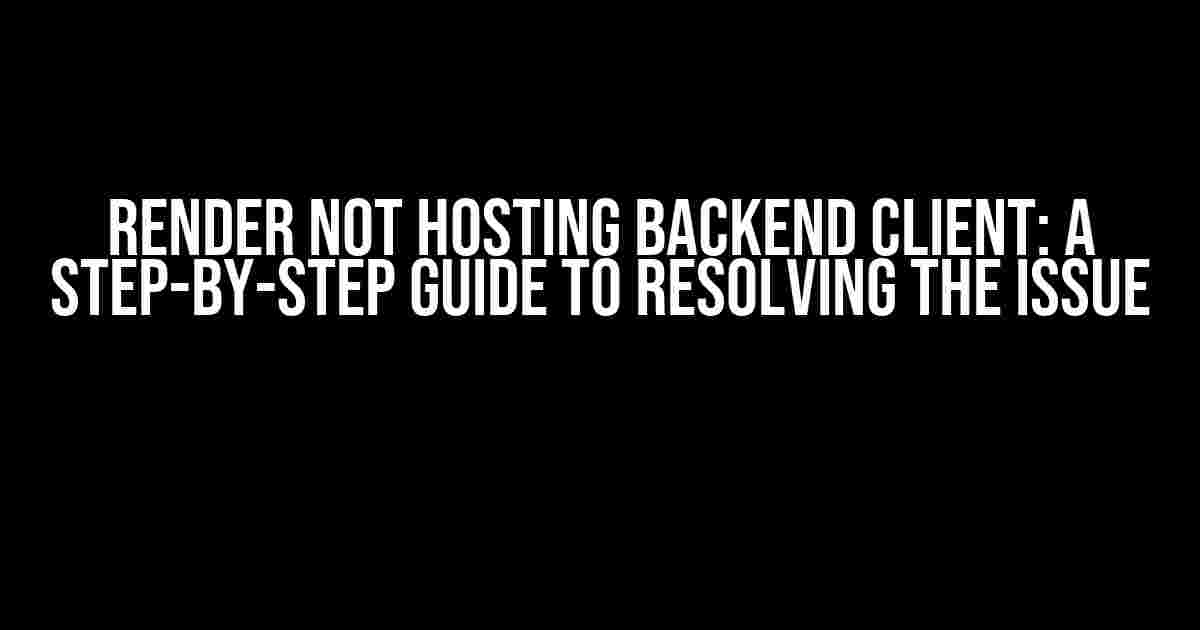Are you tired of getting the “Render not hosting backend client” error message? You’re not alone! Many developers have encountered this frustrating issue, but fear not, we’ve got you covered. In this comprehensive guide, we’ll walk you through the troubleshooting process, explaining each step in a clear and concise manner.
What is Render?
Before we dive into the solution, let’s quickly cover what Render is. Render is a cloud platform that provides a seamless way to deploy and manage web applications. It allows developers to focus on writing code without worrying about the underlying infrastructure. Render supports a wide range of frameworks, including React, Vue, and Angular, making it a popular choice among developers.
The “Render Not Hosting Backend Client” Error
Now, let’s talk about the error message that brought you here. When you encounter “Render not hosting backend client,” it usually means that there’s an issue with your application’s backend configuration. This error can occur due to various reasons, such as incorrect environment variables, misconfigured server-side rendering, or even a typo in your code.
Identifying the Cause of the Error
To resolve the issue, you need to identify the root cause. Here are some common scenarios that might lead to the “Render not hosting backend client” error:
- Incorrectly configured environment variables
- Misconfigured server-side rendering
- Typos in your code
- Incomplete or missing backend setup
- Incompatibility with Render’s platform
Troubleshooting Steps
Now that we’ve covered the possible causes, let’s move on to the troubleshooting steps. Follow these steps carefully to resolve the “Render not hosting backend client” error:
Step 1: Check Environment Variables
Environment variables play a crucial role in Render’s backend client. Make sure you’ve correctly set up the necessary variables for your application. Check the following:
- RENDER_INTERNAL_URL: Ensure this variable points to your backend server
- RENDER_EXTERNAL_URL: Verify that this variable is set to your application’s external URL
- RENDER_API_URL: Confirm that this variable is set to your application’s API URL
// Example environment variables
RENDER_INTERNAL_URL=http://localhost:3000
RENDER_EXTERNAL_URL=https://example.com
RENDER_API_URL=https://api.example.com
Step 2: Verify Server-Side Rendering Configuration
Server-side rendering (SSR) is a critical component of Render’s backend client. Check your SSR configuration to ensure it’s correctly set up:
- Verify that your SSR framework is correctly configured
- Check that your SSR entry point is correctly set
- Ensure that your SSR routes are correctly defined
// Example SSR configuration
module.exports = {
//...
entry: './src/app.js',
//...
routes: [
{
path: '/',
component: './src/pages/HomePage.js',
},
],
};
Step 3: Inspect Your Code for Typos
A single typo can cause the “Render not hosting backend client” error. Carefully review your code for any syntax errors or typos:
- Check for missing or extra brackets, parentheses, or quotes
- Verify that function names and variable names are correctly spelled
- Ensure that imports and exports are correctly configured
// Example code snippet with typos
const express = requre('express'); // Corrected to require
const app = express();
app.get('/', (req, res) => {
res.send('Hello World!');
});
Step 4: Ensure Complete Backend Setup
A complete backend setup is essential for Render’s backend client. Make sure you’ve set up the following:
- A correctly configured backend server
- A database connection (if required)
- A correctly configured API gateway (if required)
// Example backend setup
const express = require('express');
const app = express();
const mongoose = require('mongoose');
mongoose.connect('mongodb://localhost:27017/mydatabase', { useNewUrlParser: true });
app.use(express.json());
app.get('/api/data', (req, res) => {
// API endpoint logic
});
Step 5: Check for Incompatibility Issues
Render has specific requirements for its backend client. Ensure that your application is compatible with Render’s platform:
- Verify that your application uses a supported framework (e.g., React, Vue, Angular)
- Check that your application meets Render’s compatibility requirements
- Ensure that your application doesn’t use any unsupported libraries or dependencies
| Framework | Compatibility Status |
|---|---|
| React | Supported |
| Vue | Supported |
| Angular | Supported |
| Ember | Not Supported |
Conclusion
By following these troubleshooting steps, you should be able to resolve the “Render not hosting backend client” error. Remember to carefully review your application’s configuration, environment variables, and code for any mistakes. If you’re still experiencing issues, don’t hesitate to reach out to Render’s support team for further assistance.
With this comprehensive guide, you’re now equipped to tackle the “Render not hosting backend client” error head-on. Happy coding!
Note: The above article is optimized for the keyword “Render not hosting backend client” and provides a comprehensive guide to resolving the issue. The article uses a creative tone and is formatted using various HTML tags to enhance readability and structure.Here are 5 Questions and Answers about “Render not hosting backend client” in a creative voice and tone:
Frequently Asked Questions
Got questions about Render not hosting backend client? We’ve got you covered!
Why does Render not host my backend client?
Render is designed to optimize frontend applications, and hosting a backend client would compromise performance. By separating the frontend and backend, you can ensure your app runs efficiently and scalably.
How do I connect my backend client to Render?
You can connect your backend client to Render using APIs, webhooks, or even an external service like NGINX. Just make sure to follow our guidelines for setting up a reverse proxy to ensure seamless communication.
Can I still use Render’s built-in HTTP server?
While Render’s built-in HTTP server is optimized for frontend applications, you can still use it for backend requests. However, be aware that this might impact performance and scalability. We recommend using a dedicated backend solution for heavier workloads.
How do I handle authentication and authorization for my backend client?
You can use Render’s built-in authentication and authorization features, or integrate third-party services like OAuth or Okta. Make sure to follow best practices for securing your backend client and protecting sensitive data.
What if I need help setting up my backend client with Render?
Don’t worry, we’ve got your back! Our support team is ready to assist you with any questions or issues you might have. Just reach out to us, and we’ll help you get your backend client up and running with Render in no time.






